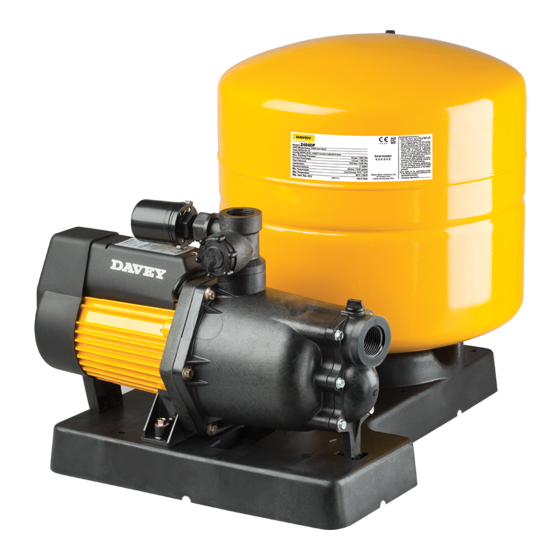
Table of Contents
Advertisement
Quick Links
Checking and Replenishing Tank Air Charge
Supercell "P" Pressure Tanks do not require regular checks
under normal operating conditions, If air charge adjustment
is required then follow the following procedures:
1. Release all water pressure from the pressure tank by
switching off the pump at the power point, and opening the
closet tap. For above ground supply tanks it is necessary
to close the gate valve between the supply tank and the
pump.
CAUTION: To prevent personal injury, ensure all water pressure is released
from the pressure system prior to work being performed.
Leave tap open during air replenishment.
2. When all water pressure has been released from the system, check air
pressure at air valve on top of pressure tank. The standard pre-charge
pressure reading should be 165kPa for X50 and 190kPa for X70 and X90
models. In any case the pre-charge should be set at 15kPa below cut-in
pressure.
3. If necessary, replenish air charge to the correct pressure indicated. Ensure
that a tap in outlet piping of pumps is open during replenishment of air
precharge.
NOTE: During air replenishment the tank should be externally inspected. Any
signs of leakage from the tank may indicate a need for immediate replacement.
Period Checks
Flushing: Depending on the quality of the pumped water, from time to time,
your tank may required flushing to remove settled fines such as mud or sand.
If sand or mud is allowed to stay in the tank, it will accelerate wear on the
internal lining and shorten your tank's life.
Safely disconnect the tank from the water supply, discharge all air from the
tank and flush the tank several times with clean water. Once the flushing
water is clean, reconnect the tank and recharge the air as per above.
External inspection: A tank in good order will not leak, but over time due to
damage through rough handling, impacts or grit and/or impurities in the water,
the tank shell may fail and/or leak. Should the tank leak or show signs of
possible failure, the tank should be immediately disconnected and replaced.
WARNING: Do not use tank if it leaks or shows signs of corrosion or damage.
Trouble Shooting Check List
a)
MOTOR RUNS WHEN SWITCHED ON BUT DOES NOT PUMP.
1. Suction line and pump body not filled with water.
2. Air leaks in suction lines or suction pipe not under water.
3. Air trapped in suction lines (also possible with flooded suction due to
uneven rise in piping; eliminate humps and hollows).
4. No water at source or water level too low.
5. Valve on suction lines closed.
b)
PUMP SWITCHES ON AND OFF FREQUENTLY (CYCLING)
1. Check that tank air pressure is correct - see above.
2. Leaking taps, float valves etc. check plumbing.
3. Leaking check valve/foot valve.
c)
MOTOR DOESN'T START WHEN SWITCHED ON.
1. Power not connected.
2. Supply voltage too low.
3. "Over temperature" cut-out tripped.*
4. Motor not free to turn eg. a jammed impeller.
5. Internal motor fault.
*NOTE: For protection, the Davey pump motor is fitted with an
automatic "over temperature" cut-out. Constant tripping of this
overload device indicates a problem eg. low voltage at pump,
excessive temperature (above 45
C) in pump enclosure.
o
WARNING: When servicing or attending pump, always ensure power
is switched off and lead unplugged. Electrical connections should be
serviced only by qualified persons.
Care should also be taken when servicing or disassembling pump to
avoid possible injury from hot pressurised water. Unplug pump, relieve
pressure by opening a tap on the discharge side of the pump and allow
any hot water in the pump to cool before attempting to dismantle.
During servicing, use only approved, non-petrochemical based oring
and gasket lubrication. If unsure, consult your Davey Dealer for advice.
WARNING: Do not use hydrocarbon based or hydrocarbon propelled
sprays around the electrical components of this pump.
In accordance with AS/NZS 60335.2.41 we are obliged to inform you that this
pump is not to be used by children or infirm persons and must not be used as a
toy by children.
Advertisement
Table of Contents

Summary of Contents for Davey Dynajet X50
- Page 1 Checking and Replenishing Tank Air Charge *NOTE: For protection, the Davey pump motor is fitted with an automatic “over temperature” cut-out. Constant tripping of this Supercell “P” Pressure Tanks do not require regular checks overload device indicates a problem eg. low voltage at pump, under normal operating conditions, If air charge adjustment excessive temperature (above 45 C) in pump enclosure.
- Page 2 Your Dynajet® system is designed to handle clean water. It should not not accept responsibility be used for any other purpose without specific referral to Davey. The use of the Do not use pipe thread sealing compounds on any part of this pump.
Need help?
Do you have a question about the Dynajet X50 and is the answer not in the manual?
Questions and answers